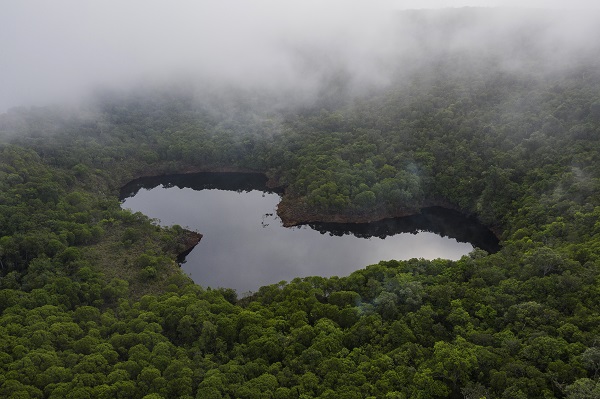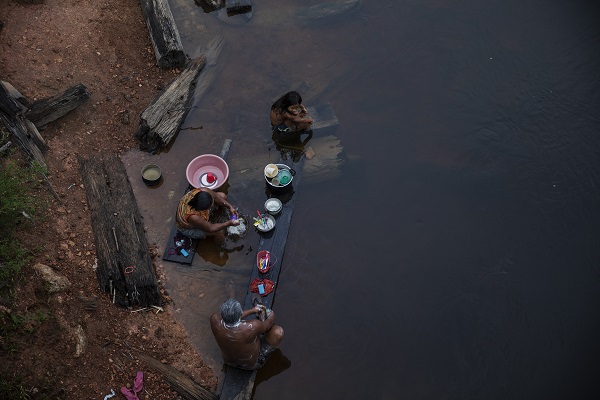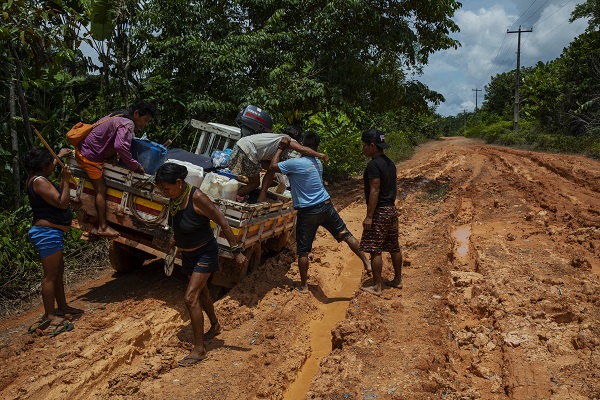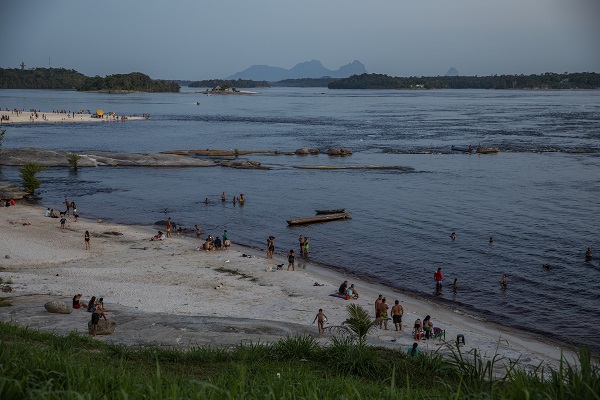São Gabriel da Cachoeira, in the state of Amazonas, a 2 hours and 20 minutes flight from Manaus, the state capital, is a green spot in the Amazon rainforest.
For the region’s inhabitants, the town is the heart of a municipality approximately the size of England, inhabited by 23 indigenous peoples.
The world’s largest deposit of niobium can be found a few dozen kilometres from the city – a mineral that has become an obsession of President Jair Bolsonaro and the Brazilian far right.
There are 2.9 billion tonnes of untouched niobium underground. Above them, mountains, rocky formations of varied shapes, orchids and many-hued lakes make up one of the most unique areas in the Amazonian region, far from the endless green plain usually associated with the rainforest.
Before the start of the novel coronavirus pandemic, this reporter and photographer visited the area, known as Seis Lagos (Six Lakes), guided by inhabitants of the Balaio TI (indigenous territory). The communities living in the TI are discussing where their region is better suited to tourism or mining, but their greatest concern is their almost total isolation due to the state of disrepair of the road leading to it, the BR-307.
“Some people would like to extract the minerals, but it’s actually very complex to work that. Others see the potential of ethno and environmental tourism”, says indigenous health worker André Veloso, 32, who guided us, referring to the views of the 350 inhabitants of the territory, belonging to several different peoples.
Again, maps can be misleading. The distance from São Gabriel to the Ya-Mirim community, gateway to Seis Lagos, is a mere 85 km by the BR-307, crossing the line of the Equator. But the federal highway is actually a muddy track that can only be traversed by Toyota Bandeirante four-by-fours. It took us four and a half hours to cover the distance, moving at 19 kph. Cost of the return journey: R$2,000.
Having arrived at the community and spent the night there, we travelled upstream for two hours on the river of the same name. Then came the most exhausting part of the trip: four hours hiking up a mountain. Along the way, the trees decrease in height as the terrain rises and the ground grows more rocky. Along the way we see the first lake, with green water, at the bottom of a valley.
We camped out for a night beside the Dragão (Dragon) Lake, surrounded by sharp earth-coloured rocks and a forest of medium height trees and bushes, some of them flowering. Mists are common in the area, and when they arrive, they cover everything in a split second.

SAO GABRIEL DA CACHOEIRA, BRAZIL. 05/10/2019. Aerial view of Dragao lake, located in the Morro dos Seis Lagos area in the municipality of Sao Gabriel da Cachoeira. This region concentrates one of the largest niobium reserves in the world and is located inside three protected lands: the Balaio Indigenous Territory, Pico da Neblina National Park and Morro dos Seis Lagos Biological Reserve. (All photos: Lalo de Almeida)
There are two almost insurmountable obstacles to mining niobium in Seis Lagos. Present legislation precludes mining in Seis Lagos. The site is included in three overlapping protected areas: besides the Balaio TI, it is part of Serra da Neblina National Park and Morro dos Seis Lagos Biological Reserve, belonging to the Amazonas state government. Mining activity is not allowed in any of these places.
Another obstacle to mining the Amazonian niobium is the lack of demand. Every projection drawn up shows the niobium deposits being mined today have enough capacity to supply the world market for many decades to come.
Brazil is already the main worldwide producer of niobium, with 88% of global production, according to the US Geological Survey. Most of the metal comes from CBMM (Companhia Brasileira de Metalurgia e Mineração), controlled by the partner family of Itaú Unibanco. Situated in Araxá (Minas Gerais state), the company estimates its deposits can produce enough niobium for at least another two centuries.
“Mining companies have no interest in Morro dos Seis Lagos,” says geologist Tadeu Veiga, at present a voluntary professor at UnB (University of Brasília). He travelled the region in 1997 as a representative of a mining company. At the time, CRPM (the Brazilian Geological Service) intended to bid for the mining rights in Morro dos Seis Lagos, but the plans never went ahead.
Despite the lack of a market for any increased production, Bolsonaro often uses niobium to justify starting mining operations in indigenous lands. The activity is allowed by the Constitution, as long as it is regulated and follows prior consultation with the peoples involved.
In 2016, while preparing for the presidential campaign, Bolsonaro produced a video about niobium, filmed in Araxá. Holding up a piece of the metal, he stated: “This can give us economic independence.” In another part of his statement he mentioned the demarcation of indigenous lands as a barrier to mining.
The most recent statement was made in June 2019. From Japan, where he was attending the G20 meeting, Bolsonaro, in a Facebook livestream, showed some costume jewellery made of niobium. He said the chain was worth R$4,000, more than if it had been made of gold.
The information is wrong. One gram of gold was worth R$293 at the end of May 2020 –more than the cost of one kilo of ferroniobium, around R$215, CBMM’s most expensive product.
The false idea that niobium could be a magic bullet that would solve the problems of Brazil’s economy comes from the ultranationalist leader Enéas Carneiro, whose ideas influenced Bolsonaro’s thinking. “Only niobium would allow us to have our own currency, backed by it,” he said in an interview in 2006, a year before his death.

SAO GABRIEL DA CACHOEIRA, BRAZIL. 05/10/2019. Indigenous people from the Ya Mirim community bathe in a river in the Balaio Indigenous Territory, in the region of Sao Gabriel da Cachoeira. The community is the closest to Morro dos Seis Lagos, region where the niobium reserves are located.
In February Bolsonaro sent to Congress a bill opening up indigenous lands to mining. Criticized by most of the indigenous movement, the bill says the indigenous peoples affected would have the power to veto garimpos (artisanal mining projects), but not large mining company projects.
Bolsonaro argued at the time, in an attempt to justify the bill, that: “Indigenous people have a heart, they have feelings, they have a soul, they have needs and desires and are as Brazilian as we are.”
Combined with Bolsonaro’s instructions to put a brake on the actions of Ibama (the state environmental agency), the promise of legalizing mining activity has stimulated an invasion of garimpeiros (artisanal miners). In April, two inspecting coordinators of the agency were dismissed as a reprisal for the closure of garimpos in Indigenous lands located in the Middle Xingu area, in Pará state.
Also boosted by the rise in gold prices, illegal garimpos have been on the increase in the Indigenous Territories of Raposa/Serra do Sol (Roraima state), Yanomami (Roraina and Amazonas), and Munduruku (Pará state), among others.
There are no garimpos in TI Balaio, but the area is on the route followed by garimpeiros on the way to illegal gold mines in the Yanomami TI and in Venezuela. They count on the tacit cooperation of the Army checkpoint on the road, which turns a blind eye to them.
When we passed through, the soldiers appeared to be concerned only with identifying possible foreign nationals. After answering a few questions to confirm our nationality, we were not even required to show our ID. In the Ya-Mirim community, at least three garimpeiros were waiting for transportation.
Area is hard to reach
The poor condition of the road leading to the area causes enormous difficulties for the Indigenous people of TI Balaio and also the Yanomamis of the Maturacá community, with around 2,100 inhabitants. To reach their homes, they still need to travel for about a day on the Ya-Mirim river, that crosses the community, on canoes powered by the cheapest outboard engine.
The indigenous people go to São Gabriel da Cachoeira frequently to receive their Bolsa Família and other benefits. Quite often they spend all the benefit money on transport.
Due to the high cost, several families often share the rental of the Toyota. The open back part of the pickup is shared by many people, including children and seniors. Mechanical problems and breakdowns in the mud are the rule rather than the exception, and travellers often have to spend the night on the road until they can be rescued by another Toyota driver.

SAO GABRIEL DA CACHOEIRA, BRAZIL. 05/10/2019. Pick-up trucks travel along the road BR-307 on the stretch that connects Sao Gabriel da Cachoeira to the Ya Mirim community within the Balaio Indigenous Territory. The road is the only access to several indigenous communities in the region
“It’s a sad business. People here face great hardships,” says Tiago Fernandes Sampaio, 49, president of the TI Balaio association and a member of the PSDB (Brazilian Social Democracy Party). “It used to be that the trip took two hours. Not now, though. Sometimes you leave before dawn and arrive at dawn of the next day. The Toyota auto parts break down midway. If you are taking people who are gravely ill to get help, they sometimes die on the road.”
Besides the locals and garimpeiros, this route is also followed by tourists who want to climb Pico da Neblina, the highest peak of Brazil, accessible via Maturacá. The mountain is located within the Pico da Neblina National Park and also within the Yanomami territory. Before the Covid-19 pandemic, the trip to São Gabriel was made by air from Manaus. There used to be three commercial flights a week, but they have been suspended due to the pandemic.
Authorized by Funai (the governmental agency for Indigenous peoples) and ICMBio (administrative arm of the Ministry of the Environment), the visitation project was seen as a source of income for the Yanomami of Maturacá and was intended to start in March, but the Covid-19 pandemic has postponed it indefinitely.
The experience of Yanomamis receiving visitors has been closely monitored in the TI Balaio. “The most feasible option for us right now would be tourism,” says chief Veloso, of the Desana people, comparing it to mining. “We have many beautiful spots, the community, waterfalls, small rivers which allow for bathing. All that is needed is some structure and organization.”
“Adding ecotourism to the ethnic experience of spending time with indigenous peoples, who would be visitors’ hosts, would add a special flavour to this destination,” says tourism entrepreneur Kleber Bechara, former head of the Seis Lagos Rebio (Biological Reserve).
He believes there is potential for expedition tourism. “This is a remote area, difficult to access. With the proper infrastructure it could become an added attraction for a specific niche of the public that is interested in having experiences of this kind, with safety.”
The Army’s Centre for Social Communications reported by e-mail they are carrying out repairs and maintenance by means of two operations, at a cost of R$19,2 million, to ensure the road is usable up to TI Balaio. The work is forecast to be completed by November this year.
Regarding the policy of allowing garimpeiros to pass through the checkpoint, the answer was “there is no kind of checkpoint maintained by the Brazilian Army on the aforementioned BR (highway).”

SAO GABRIEL DA CACHOEIRA, BRAZIL. 05/10/2019. Local fishermen use nets to fish on the rapids of Rio Negro in São Gabriel da Cachoeira, Amazonas State
With or without niobium extraction, mining has been one of the issues most discussed among the indigenous peoples since the 1970s, at least, when the region was invaded by garimpeiros and mining concerns.
To expel them, the indigenous people organized themselves in Foirn (Federation of Indigenous Organizations of the Rio Negro), that was created in 1987 and lobbied for the demarcation of indigenous lands. Today the organization brings together 90 associations representing 700 communities and around 50 thousand people divided between 23 indigenous peoples.
“They invaded our territory, and we had no security. Indigenous people and garimpeiros were slaughtered,” says the head of Foirn, Adão Henrique, of the Baré people. “Thanks to the strength of the movement and to Funai, they retreated.”
Contrary to Bolsonaro’s suggestion, the federal government has never got in touch with Foirn to discuss mining, says Henrique. According to him, the organization is open to discussing the question.
“We want development, but with participative discussion. It has to be done step by step, following legislation, both international and Brazilian,” he says. “Our movement will continue to strongly oppose the proposals of the present government. We don’t want the Rio Negro indigenous peoples be harmed or deluded with projects destined to fail.”

SAO GABRIEL DA CACHOEIRA, BRAZIL. 05/10/2019. Residents enjoy Sunday at a Rio Negro beach in Sao Gabriel da Cachoeira.
Politically distant from Foirn, the mayor of São Gabriel da Cachoeira, Clóvis Saldanha (PT), known as Tarubão, of the Tariano people, was elected on the promise of regulating Indigenous garimpos – he has worked on garimpos himself. When he became mayor, in 2018, Saldanha created the Responsible Smallhold Mining Department, with the aim of promoting mining without the involvement of large companies.
One of the department’s advisors is Cisneia Menezes Basilio, of the Desana people. She graduated from Ufam (Federal University of Amazonas) and is the first indigenous geologist in the country.
Basilio says there is great geological diversity in this region, but it has been little studied so far. She mentions deposits of tantalite (used in the tech industry) and gold, as well quartz and gemstones such as amethyst, quartz, and aquamarine beryl. Like other specialists, she doesn’t believe it is feasible to mine niobium in Seis Lagos.
In the mayor’s office, the geologist says the aim is to stimulate the incipient production of biojewellery, training craftspeople and taking information about mineral exploration and legislation to the communities.
“When the communities heard about the existence of the department and that it had a geologist, they started coming to us with their samples to try and identify them, wanting to know about prices and imagining that those little quartz, amethyst or tantalum stones would be able to change their lives,” she said in an interview in her office, where she keeps several of these samples.
“What the people of São Gabriel need isn’t liberation or mining, but information. What is being discussed in Congress are large-scale mining operations, and our people at the grassroots often imagine this is something that will give them work and will benefit them directly. We know that is not true,” she says.
“We don’t lie to them, on the contrary. Our department’s role is to inform the people of their rights enshrined in the 1988 Constitution and research possible activities in which indigenous people can be the main actors and can enjoy the fruits of their natural resources.”
This reporting is part of The Amazon under Bolsonaro, a collaboration between Folha De S. Paulo and Climate Home News. All photos: Lalo de Almeida/FolhapressSilva. Translated from the Portuguese by Clara Allain